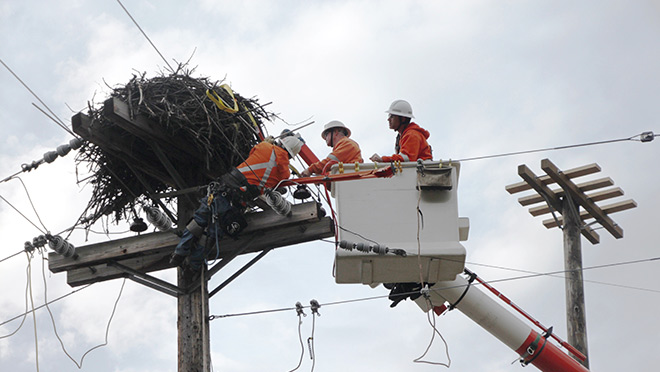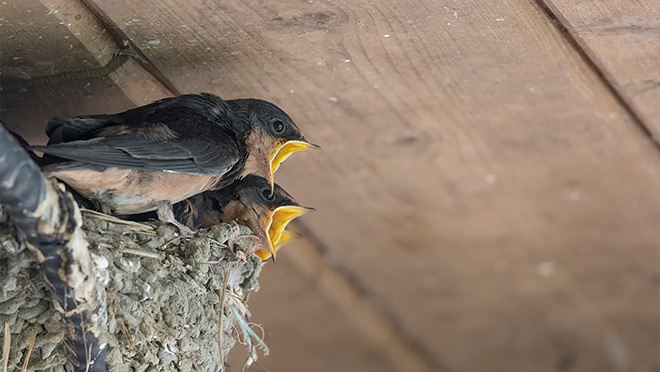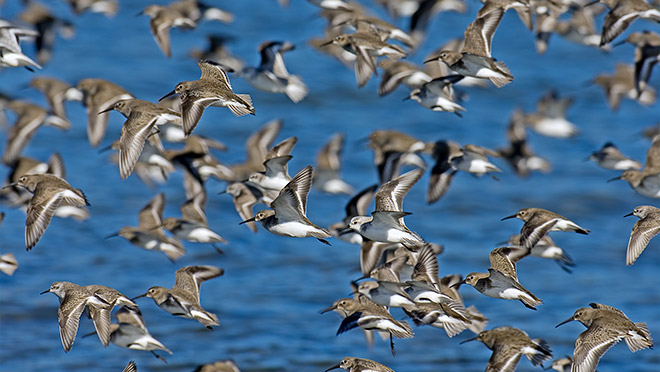Ideas big and small help protect birds, snails, bats, and sturgeon

Our work to protect biodiversity on rivers, near power lines
Rather than spray an entire cliff face at Seven Mile Dam near Nelson with concrete to prevent erosion, our team preserved cracks in the cliff face that bats use for raising their pups. A three-hour drive away, on a shoreline just south of Revelstoke, juvenile white sturgeon are released into the Arrow Lakes each spring to help enhance the survival of the giant, endangered fish.
Meanwhile near a stretch of Highway 1 in the Fraser Valley, plans to relocate our power lines got shifted at what you might call a snail's grace.
And at several areas throughout the province – including nesting areas for barn swallows and ospreys in the B.C. Interior, and power lines that can pose safety issues for migratory birds in Delta – detailed studies led to actions to protect birds.
These are just four ways we're working with a variety of partners, including First Nations, to help protect biodiversity as we build, maintain, and operate our infrastructure to generate and deliver clean electricity to B.C. homes and businesses. While encouraging the switch from fossil fuels to clean electricity, we can play an important role in the fight against climate change. However, electrification initiatives are not without environmental impacts that could threaten B.C.'s biodiversity – the variety of animals, plants, fungi, and even microorganisms that make up our natural world.
Our system has both positive and negative effects on the environment, and we have a responsibility to make good environmental decisions that avoid, reduce or offset the negative effects. Here's a look at how we're making that happen.
When endangered Oregon forestsnails were found near a site in the Fraser Valley where power poles were to be relocated, we reworked the project to avoid impacts to the snail’s habitat.
Plan B: Redesign a power line to help an endangered snail survive
The plans for the relocation of three power poles and an access road in the Fraser Valley got scrapped in 2022 when the impacted area was identified as critical habitat for the Oregon Forestsnail, a land snail identified as endangered under the federal Species at Risk Act due to the cumulative impact of ongoing incremental habitat loss in the Lower Mainland.
The transmission and distribution power lines project was an offshoot of a BC Ministry of Transportation and Infrastructure project to upgrade a railway overpass in the Fraser Valley as part of the highway expansion project. We had a plan to move existing power lines to accommodate the larger project, until environmental consultants and our team, Fraser Corbould and Rob Sicotte – discovered a problem.
"We found the western end of the project had vegetation that was characteristic of the snails' critical habitat," recalls Corbould, a senior environmental coordinator. "And we also observed a significant number of snails, right where we were planning to put three poles, a number of anchors and an access road. It was quite obvious that it was the best habitat in the area for the forestsnails."
Corbould worked with project managers and designers to eliminate three transmission spans to avoid the snail habitat, and in the process, there was another environmental win. "The adjusted design meant we also didn't have to conduct work around a creek or relocate additional distribution infrastructure," he says.
While the total area of habitat saved was small, it is exactly these kinds of decisions that can help curtail the cumulative impact of the many pressures associated with human development in the Fraser Valley, that nibble away at the remnant patches of critical habitat. For this little snail, these kinds of actions are essential to support its recovery.
New poles, new nesting platforms for osprey
If you've ever been lucky enough to see a large raptor dive out of the sky to snatch an unsuspecting trout out of a B.C. lake, it's a good chance that bird was an osprey. They love fish, and as it turns out, they love to build nests on our power poles.
This often happens in areas of B.C. near rivers and lakes where forests have been cleared and few natural nesting areas remain. But nests on power poles, which can cause power outages and in some cases fires, need to be removed for the safety of both the birds and people.
That's why, rather than just try to make our power poles nest-proof, our crews install new power poles with dedicated nesting platforms for osprey. Sometimes, nests are carefully removed from a power pole to a new nesting platform nearby. You can see how this is done, and see just how big these nests are, in this story and video on vancouversun.com.

A condo is built for barn swallows at John Hart dam
Like the osprey, barn swallows also have a habit of taking advantage of structures that humans build. That includes structures at Vancouver Island's John Hart dam, where we're working on a seismic upgrade project.
Protected by the Species at Risk Act (SARA), barn swallows nest almost exclusively around barns and other outbuildings. So we've built a large shed at the dam site – we're calling it the barn swallow condos – with the expectation the birds will find a safe haven there during the seismic upgrade project.
While they start out small, juvenile sturgeon released into the Arrow lakes can grow into the largest freshwater fish on the continent, sometimes as long as six metres.
'Jurassic' fish get a boost in the Arrow Lakes
About 150 juvenile white sturgeon were released into the Arrow Lakes this past May as part of an annual release that's a big hit with the public. Volunteers show up to take part in a release that helps enhance the survival of the endangered fish, which is the oldest and largest freshwater fish in North America.
Sturgeon can grow up to six metres long and more than 800 kg. But the one and two-year-old juveniles released at Shelter Bay in Arrow Lakes Provincial Park were all less than 1 kg. Organized by the Fish and Wildlife Compensation Program (FWCP) and the Revelstoke Rod and Gun Club, BC Hydro, and the Freshwater Fisheries Society of BC, the annual release drew more than 200 students and members of the community to help with the release.
Since 2000, 137,000 juvenile white sturgeon have been released as part of the program. But the adult population in the Arrow Lakes reservoir is estimated to be only abut 50 adults. Biologists are still doing research to understand why white sturgeon are in decline, but we know that human activities are likely factors.
Bats keep their nesting places on a Kootenay cliff face
A project to use sprayed concrete to stabilize a cliff face above an office building at our Seven Mile Dam near Trail was delayed when some local residents – bats – let us know that this was their territory.
A bat biologist working with us used acoustic monitoring to discover that bat activity at the cliff increases during pup-rearing season. The conclusion was that the bats use cracks in the cliff face as roosts, and potentially for the pup-rearing.
Work was scheduled outside of the period when bats were using the cliff, and we found a way to protect the most suitable cracks for the bats while still carrying out the cliff stabilization. The good news is that bat activity in pup-rearing season after the project has shown no significant decrease from that shown before the project began. And we're doing a similar study led by Joyce Ip on a cliff face at Terzaghi Dam near Lillooet that's frequented by bats, birds, and mountain goats.

Diverters help birds avoid power lines at Deltaport
Coastal wetlands near Deltaport, a container shipping terminal in Delta, are used as foraging habitat for a variety of migratory birds including the dunlin and western sandpiper. But the power lines that supply electricity to the terminal can be a hazard to migratory birds.
Over the last two years, we've funded a project to install diverters – devices attached to wires to make them more visible to the birds – on a stretch of overhead transmission lines that supply power to the terminal. While we've done this elsewhere in B.C., the project is the largest diverter project we've done so far, with almost 5,000 diverters installed over 5 km of power lines.